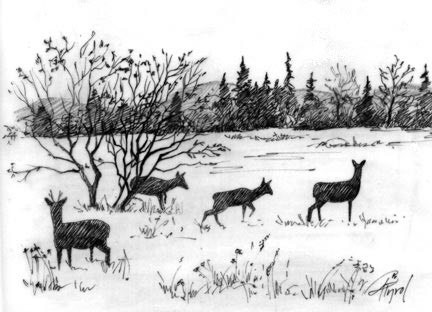
We live surrounded by deer. They observe us as we cut wood, walk in the woods, or step out back to hang the laundry. They turn up at the edges of fields, deep in the woods, or in the rough between suburban houses. But for all their abundance, we rarely see them. And except for a few short weeks in November, few of us give deer a second thought.
Deer thrive in our midst because, like us, they are generalists. White-tailed deer are found in all 50 states and all but the most northerly Canadian provinces. They eat a wide range of foods and, also like us, don’t necessarily eat what is best for them; although starving deer will invariably choose the most nutritious foods available, well-fed deer have been observed by biologists walking right past healthy food to sample new or unusual treats.
In addition to being generalists, whitetails have a second crucial ability that has contributed to their ecological success: their fertility rate adjusts itself each year to match changes in food availability. If food is plentiful, does will have two or more fawns each spring. If food is scarce and starvation is threatening, does will either not conceive at all, will conceive only one fawn, or will abort one or more fawns before springtime.
All of which brings us to November, the annual period so anticipated by hunters and so dreaded by hunting’s opponents. Though much of the hunting debate revolves around guns and gun control, most of the details of the actual hunt are based on the biology and ecology of the deer herd.
For example, hunting season is held in the fall not arbitrarily but for two important reasons. First, fall is “the rut” for deer – the annual mating time during which both does and bucks – but especially bucks – lose their normal wariness and pursue sex at the expense of safety. Bucks in other seasons are often so elusive that even catching a glimpse of one is an unusual occurrence. Hunters armed with the latest in rifle technology would have little chance of shooting a buck in May; as it is, only about one hunter in eight is successful during Vermont’s and New Hampshire’s autumn hunting seasons.
But hunting season is held in the fall for a second important reason – the more deer that die in the fall, the fewer that are likely to starve in the winter. In the absence of hunting and predation, nearly all deer mortality occurs in the winter when food disappears and shelter is restricted to thick softwood stands. Following particularly harsh winters, deer fecundity is also suppressed since the does have had to endure limited food during the winter.
When deer are removed from the herd by hunters and, more recently, by coyotes, the opposite effect occurs: fewer adults compete for the same food, fertility rises, and more fawns are born in the spring. When hunting, predation, and habitat are all in balance, the deer herd tends to be steady in size, and individual deer tend to be both large and healthy.
The job of balancing all these factors falls to biologists in the state wildlife departments, who monitor the deer herd to determine the rules and regulations of each hunting season. If there are too many deer, individuals become smaller and less healthy, and ground-nesting songbirds (and other species that live in the undergrowth) suffer as deer eat everything in sight – including carefully tended flower beds. Biologists attempt to reduce the herd by lengthening the hunting season, increasing the number of deer that each hunter can shoot, and allowing does to be killed along with bucks.
And if there are too few deer? Only once in thousands of years has this happened – during the great sheep boom of the nineteenth century when market hunting of venison was legal and most of our forests were leveled for pasture and lumber. Of these two factors, the loss of habitat was the most significant; deer can recover from heavy predation if adequate food is available, but they cannot rebound if they have neither food nor shelter during the critical winter months.
But wouldn’t deer be better off if we just left them alone? Anthropologist Richard Nelson, whose book Heart and Blood: Living With Deer in America should be in the hands of everyone who loves deer, hunter or not, reminds us of our history. “Humans have likely been the most important predators on deer for thousands of years. We ourselves – and the hunger in our bellies – may have influenced the evolutionary sculpting of this creature. Selective pressure from human hunting would have favored traits such as acute senses, secretiveness, wariness and escape behaviors, camouflaging coloration, cryptic patterns of body movement, and fleetness of foot.”
In short, deer are what they are because of us. And we because of them.

